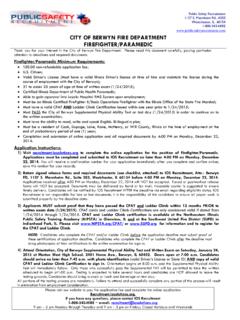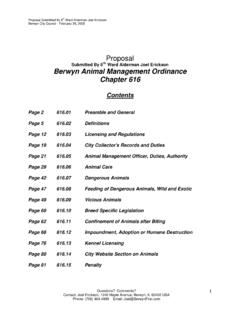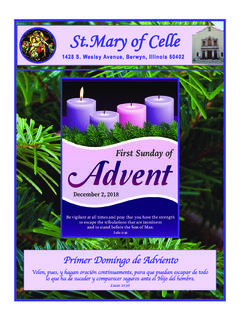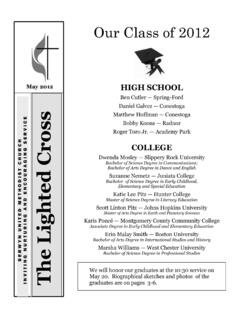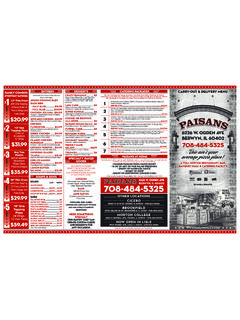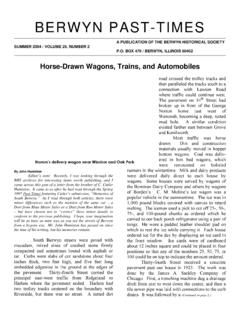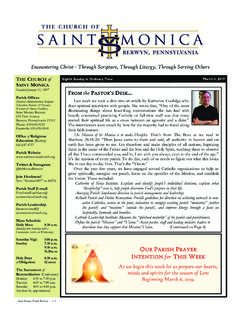Transcription of Walking Indian history. Men from this area Tour
1 A Self-Guided Walking Tour Historic berwyn HeightsHistoric berwyn HeightsHistoric berwyn HeightsHistoric berwyn Heights The berwyn Heights Historical Committee welcomes you to Historic berwyn HeightsHistoric berwyn HeightsHistoric berwyn HeightsHistoric berwyn Heights (301) 474-5000 One of Maryland s 14 municipalities within the Anacostia Trails Heritage Area T he land on which berwyn Heights is located was home to Native American Indians as far back as 8,000 years ago. In 1608, Al-gonquian-speaking groups, which were part of a chiefdom called the Conoys, inhabited the river and creek areas of the Potomac River.
2 The Conoys of the Indian Creek area were the Na-cotchtanks (Anacostanks). Dennis Webb, a berwyn Heights resident, identified one of the largest American Indian sites on the East Coast, on In-dian Creek. The state government holds thousands of artifacts from the site. Artifacts from these people con-tinue to be found in yards and gardens throughout berwyn Heights. The first English colonists had ex-tensive contacts with the Conoys be-ginning in 1634. Many precautions were taken to ensure peace in the in-tervening years through 1696 when Prince George s County was estab-lished. A troop of rangers were main-tained to cover the frontier plantations from the Anacostia to the Pennsyl-vania line.
3 In 1700, the Conoys were removed to Pennsylvania, but, inci-dents involving Indians continued be-tween 1699 and 1738. By 1700, the Algonquian culture, which had sur-vived here for over a thousand years, vanished. During the 18th Century, the area of our present town was known as the New Scotland Hundred. Tobacco was the chief money crop of the Maryland colonies, where slaves and indentured servants performed much of the inten-sive manual labor. Black history is in-terwoven with colonial and American Indian history. Men from this area fought in the American Revolution. The gravesites of two Revolutionary soldiers from the Walker family are located just outside the town at the end of Walker Drive in a DAR au-thenticated cemetery.
4 At one time the Walker family owned all, or a large portion, of berwyn Heights. The Town of berwyn Heights offi-cially came into being on April 2, 1896, by an act of the Maryland Gen-eral Assembly. Don Skarda in his History of a Small Town tells us that the charter specified the corporate lim-its of the Town to include all the same land contained in Edward Graves sub-division of the tract of land heretofore known as Charlton Heights. The Charter called for the election of three commissioners to serve for 1 year, without pay, to administer the affairs of the Town. They were authorized to appoint a Town Clerk to keep appro-priate records and a Bailiff to preserve peace and order.
5 The Commissioners were authorized to levy taxes on all real and personal property. The char-ter specified that an election of Com-missioners was to be held on the first Monday in May in the year 1896. However, the official establishment of the Town did not become a function-ing reality until 28 years later. Since its inception in April 2003, the BHHC has imple-mented several ambitious and successful projects: THE ORAL HISTORY PROGRAM The BHHC conducts audio/video interviews with past and present residents to record descriptions and details of what life was like in the early days of our town. HISTORIC STREET MARKER PROJECT Each year, the BHHC dedicates a Historic Street Marker to honor the people, buildings and sites of historical significance in berwyn Heights.
6 SELF-GUIDED WALKI G TOUR BROCHURE This fold-out brochure features a map with photos to guide walkers, hikers and bikers on a mile-long tour of some of our town s most cherished historic homes, as well as the locations of the Historic Street Markers. MUSEUM / EVE TS The BHHC has a small museum at the Town Center and also hosts several events each year, from area mu-seum tours and book signings, to historical-themed holiday receptions and anniversaries. We welcome you to drop in at our monthly meetings, held every fourth Tuesday of the month at 7:30 , in the Town Of-fices. To contact the BHHC, call 301-474-5000, Mon-day Friday, 8:30 5:00 ATHA is a State of Maryland Certified Heritage Area that encompasses 14 municipalities, as well as many neighborhoods in the unincorporated portions of north-ern Prince George s County.
7 Founded in 1997, ATHA, Inc. is a 501(c)(3) grassroots organization dedicated to advocate for, organize and promote heritage tourism in a way that fosters economic development, while re-vealing and protecting the cultural, historic and natural resources in each community within the Anacostia Trails Heritage Area. To learn more about the organization, or to become a member, visit: , or phone: (301) 887-0777. The berwyn Heights Historical Committee (BHHC) Anacostia Trails Heritage Area (ATHA) TTTThe Tourhe Tourhe Tourhe Tour Y our tour begins on berwyn Road at Ruatan Street and its length is just shy of a 1-mile loop (see map).
8 Along the way, please feel free to drop by our Town Center where you can obtain more informa-tion about our town, its history and upcoming events. In the first two blocks of the tour you ll see the highest concentration of the Town s historic structures in an area of about 800,000 square feet. The eight houses highlighted in this bro-chure were each evaluated and sur-veyed in 1986 by Susan Pearl of the Maryland National Capitol Park and Planning Commission (M NCPPC). The eight featured homes range in date from 1888 to the 1920 s. Seven of the eight are Victorian, and were built almost simultaneously by the Charlton Heights Improvement Company dur-ing its very short life.
9 The eighth home, the school house, was built in 1922 and functioned as a public ele-mentary school until 1958, then was converted into a private residence in the 1970s. Most notably, four of the listed houses were built using Robert Shoppell s pattern-book plans, distrib-uted by the Cooperative Building Plan Association, and remain some of the finest examples of Shoppell homes in the area. Please note, however, that all the homes featured on this tour do not have official designation as County historic homes. The berwyn Heights Historical Committee (BHHC) plans to add other Walking tours within Ber-wyn Heights to include those resi-dences that already enjoy historic des-ignation on the County and/or Na-tional Registers, and the others that will soon become eligible for consid-eration.
10 Included on this map, you will also see the locations of the Town s Historic Street Markers which ac-knowledge the original street names and honor the people, buildings and sites of historical significance in Town. The following houses in this tour, are named after the original owners/builders of the structures. 2013 berwyn Heights Historical Committee 1. Kleiner House (1888) 5603 Ruatan Street L arge two-and-one-half story gable-roofed frame house of late-Victorian-Shingle style, with three-story octagonal corner tower with abundant Queen-Anne-style decorative detail. This house is an outstanding example of a late Victorian pattern book house (Shoppell Model #462).
